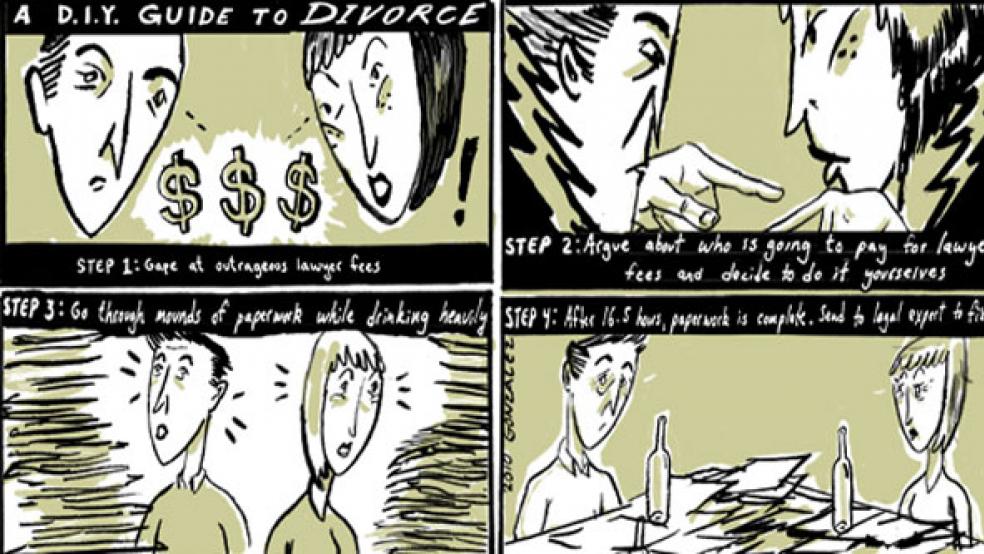When Mark Larsen’s wife announced her intention to divorce in July of 2007 after 18 years of marriage and with three kids still at home, Larsen had other things on his mind besides the emotional sting. He’d started his own consulting business a month before her announcement and it was tanking along with the rest of the economy. The couple shared a $400,000 mortgage in a suburb of Chicago that was quickly heading underwater, and according to Larsen, his wife said she would no longer help make the monthly payments.
To handle the divorce process, Larsen first sought out an attorney, but at a $650 hourly rate, he quickly racked up $5,000 in fees. “The prices were ridiculously high.”
Larsen soon found a more economical attorney who charged $250 an hour, but he was disappointed again. “She was unorganized. I was blowing through money like water, and I was getting nowhere.” After spending another $10,000 for her work, he decided to forego lawyers altogether and go at it alone: He would represent himself.
With the recession continuing to inflict financial hardship on many families, Larsen is one of many who have decided to buck the system and go rogue when it comes to divorce. Instead of spending what little they have on pricey attorneys, these mavericks are doing what all DIY aficionados do: using ingenuity along with trial and error to figure it out on their own.
Though some in legal corners have serious objections to the DIY movement, others support it. “It does give people greater autonomy,” says Robin Fretwell Wilson, a professor of family law at Washington and Lee University in Lexington, Va. “It’s why we have no-fault divorce, because what business is it of the state to be mucking around in people’s private affairs?”
More DIY Services on the Rise
The recession has caused an increase in a host of DIY legal services, in addition to divorce: bankruptcies, estate planning, child custody, and housing court issues. Tax preparation has also been affected. E-filing through TurboTax and other competitors has risen 10 percent or more during the recession. Mary Fox, a clerk with the Brooklyn bankruptcy court whose sole duty is to advise people interested in DIY bankruptcy, says that in June, 56 percent of the Chapter 13 bankruptcies at the Brooklyn courthouse were DIY. “There are a lot more people coming to see me. I started here four years ago with maybe 80 people a month, and now we’re at maybe 250 people or higher a month.” Fox cautions, however, that the failure rate of these DIY bankruptcies is astoundingly high. By law, everyone has the right to represent themselves and file without help, but Fox encourages her clients to seek legal representation or advice from a certified lawyer. “It’s complicated. People don’t know what they’re doing.”
much more active,” says one attorney.
Divorces, which waned during the recession, are beginning to creep up again, as couples who delayed filing for the past few years are either finally fed up and ready for a clean break, or feel they’re becoming financially stable enough to afford the process. “At the end of 2008 and into 2009, fewer people were getting divorced. It was like somebody turned off a spigot and the phones stopped ringing in law offices,” says attorney Pamela S. Wynn, who runs a service called DIY Divorce in Florida, and offers a class to those interested in doing it on their own. “It’s picked up in the past six months. The phone is much more active.”
However, the divorce services that are doing the best aren’t the $650-per-hour lawyers; they’re the cheap attorneys with lower-tier law school degrees and dowdy offices, the discounted and sometimes shady legal consultants, and the do-it-yourself advice services.
As with most DIY projects, mistakes are common, but with legal services, each one can cost big bucks. “Attorneys can drive up the expense in the moment, but over the long haul, they may end up saving you a ton of money,” says Wilson of Washington and Lee University. She recommends spending some money upfront to get advice before deciding if DIY is the way to go. For example, if a couple has children, property and financial complexities like shared or individual debt, the process can be excruciating, with more opportunities to make mistakes. If the couple doesn’t agree on everything and there’s going to be a custody battle, hiring legal counsel is in its best interest. For simpler cases, though, some states offer mail-in divorces, and many cities have legal clinics and court consultants that give free or discounted advice.
The Devil Is In the DetailsMark Larsen spent over 50 hours preparing for court by reviewing documents and filing motions, but says he still felt woefully unprepared. “I didn’t do a phenomenal job. I could have used someone as a coach for what to expect. The tough part was in the technical details. They were disputing things that I thought were just indisputable. I was essentially becoming a divorce attorney.”
Wynn, who runs the DIY Divorce advice service, charges $149 for her DIY divorce class, and $300 to $450 to review documents. There’s also a $400 filing fee in Florida that everyone has to pay. Since a divorce can run, on average, from $20,000 to $50,000, the cheaper options are growing in popularity. Silviane Steinbatch, who helps run a company called Conexa in Nevada — its tagline is “attorney representation…paralegal prices” — says the firm started in 2008 in order to take advantage of the growing demand for cheap divorces. Lately, business has been booming. “We’ve streamlined the process. When clients don’t want to pay $1,500 or $2,000 to an attorney for an uncontested divorce, we do it for $399 if there are no children or property.” The company keeps costs down by having paralegals do the work, which attorneys then review. The firm also handles discounted annulments, bankruptcies and living trusts.
Wilson says that on the whole, the divorce process has become much easier over the years, mainly because of no-fault divorces, which begs the question: If it’s easier and cheaper than ever to get a divorce, will more couples do so? “That’s a very contested question,” says Wilson. “Some of this may be cultural, but some feel when we moved to no-fault, we had a lot more divorce and it made the court sort of a divorce mill.”
Even though it’s uncertain if he’ll be saddled with more debt from the marriage (his ruling date is this fall), Larsen says if he were to do it all over again, he’d still take the DIY approach. “I would have done it by myself from the get-go, but I would have hired an attorney to consult with periodically.”
THE BOTTOM LINE ON DIY DIVORCE |


